So here I am at bread number 19 out of the Breadbaker's Apprentice book, and if you have been keeping up with these blogs you know the rules of the Challenge already. Nicole from Pinch My Salt did a beautiful marbled loaf that looks too gorgeous to even eat, and I think that she used the caramel color to get that dramatic look. I used the coffee/cocoa substitution instead of the caramel color, and the contrast was definitely not so striking. As I am baking my way through all the recipes, I have noticed that my starter seem to react differently from each type of flour used in incorporating it-- weird. If you don't want to buy the book, you can find the recipe here.  First, I made the darker dough with the coffee/cocoa mix I combined all the ingredients together in my mixer and mixed until it came together into a uniform ball.  I made the same dough again, but left out the coffee/cocoa mix. Of course, this is my lighter rye. 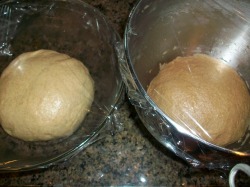 Here are the two loaves left to bulk rise.  When the dough doubles in size go to Elizabeth's site to see how she gets the marbling on her bread.  Out of the oven and sliced, this was more impressive than I thought it would be, and although I still am not a rye lover, I will send it over to yeastpotting.
1 Comment
I was really excited when this next bread was next in line for the Breadbakers Apprentice Challege. I really like the nutty, earthy, and wheaty taste of whole wheat, but this bread was NOT the kind of wheat bread for wheat lovers like me. However, if you are into a wheat bread that only slightly resembles wheat, then this is the bread for you. I found the taste and texture more like a white bread with only a hint of wheat flavor and a little honey. 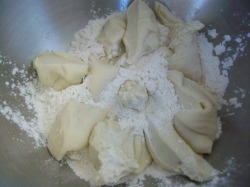 Here are the ingredients: 1-1/4 cups water, at room temperature 2 tablespoons shortening 3 tablespoons non-fat dry milk 1-1/2 teaspoons salt 2 tablespoons sugar 3 tablespoons honey 2-1/2 cups bread flour 1-1/2 cups whole-wheat flour 1 cup of Adam(my wild yeast) 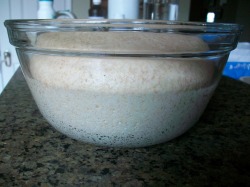 The First Rise  I then divided the dough and made two loaves in 8.5 inch loaf pans.  The golden color was a beautiful sight. Should this photo be yeastpotted?  The crumb wasn't too bad either.
I absolutely LOVE Lavash Crackers. And I was really glad that Peter Reinhart included one in his book The Breadbaker's Apprentice. This is recipe #17 in his book and as per the rules of the Bba Challenge, I cannot post the recipe, but if you don't have the book, you can find the recipe here. The origins are credited to Armenia where the delicious flatbread is traditionally rolled thicker and cooked in a Tandoor oven. And although lavash flatbread is delicious, the cracker... well, in my opinion, is the epitome of texture and taste! I have to admit, I wondered what the yeast would do to the crackers, but the slight rise only contributed to the bubbling and the more tender taste of the final product. I have read many other blogs out there who didn't like this recipe, but I halved the recipe, and divided the dough again in the end, because the dough had to be rolled ultra thin to make the flatbread. I took the other half and formed some grissini. If you have any doubts about this recipe, make half, and roll it out "paper" thin and I am sure you won't be disappointed! 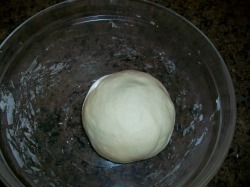 Here is the finished dough ready for the initial rise. I let the ball of dough ferment until it doubled in size 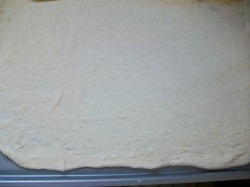 I divided the dough in half(remember, I halved the recipe as well), and rolled one half super thin to get a cracker consistency at the end. This is the secret to a really successful yeast cracker.  I then topped the rolled dough with poppy seeds, sesame seeds, paprika, and sea salt. Reinhart gives the option of sprinkling caraway seeds also, but, I am not personally fond of those. 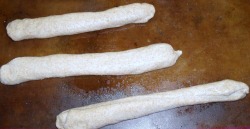 I also made some grissini from the left over dough which actually turned out wonderful. 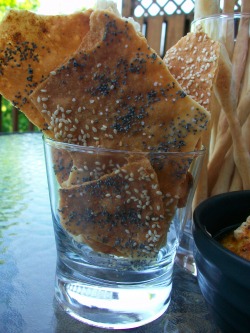 Delicious and wonderful with hummus! A must try and again good enough for yeastspotting.
The Kaiser roll, also called Vienna roll, is a crisp crusted roll the size of a hamburger bun. It was supposedly created in Vienna, and is thought to have been named to honor Emperor Franz Josef. Also known simply as a hard roll. Today, we typically associate the roll by the star shape on top, and it is simply a glorious vehicle to use as a coat for delicious sandwiches. I can't say that I have ever really liked these rolls until now. Somehow baking them fresh from your oven just makes them taste better! Since I am participating in the Breadbakers Apprentice Challege, I am not supposed to post the recipe, but once again, someone else has so you can find the recipe here 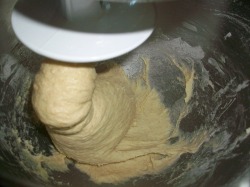 kneading with dough hook I started out with the ingredients: flour, water, egg, Adam(my wild yeast), salt, shortening, and barley malt syrup. Mixed up everything until came together in a ball and then proceeded to use dough hook on med for about 4-6 mins. 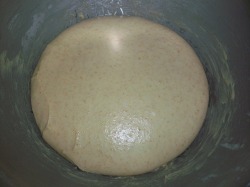 first proofing The dough is left to rise 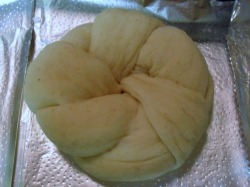 knotted dough I then divided the dough into 8 pieces and rolled and knotted them as you can see here.  puffed knotted rolls The rolls were then left to rise, and they puffed up beautifully. I then brushed each roll with milk and topped them with sesame seeds. 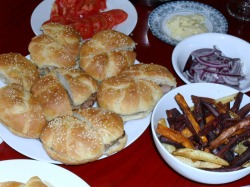 delicious as burgers The Kaiser rolls were delicious as burger buns, and I shared them with my sis and her family. They didn't last very long! yet another one for yeastspotting.
|


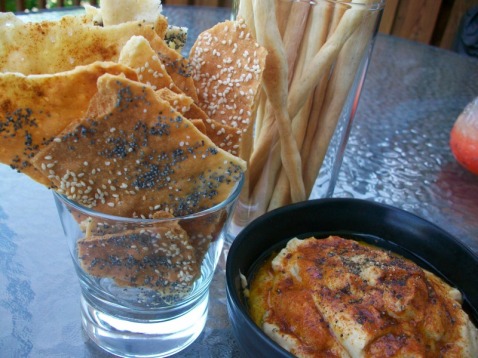

 RSS Feed
RSS Feed